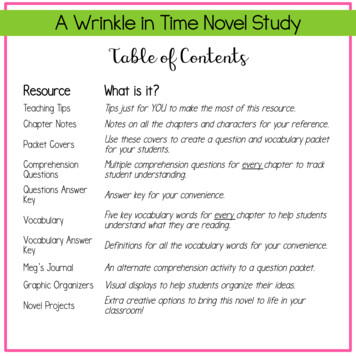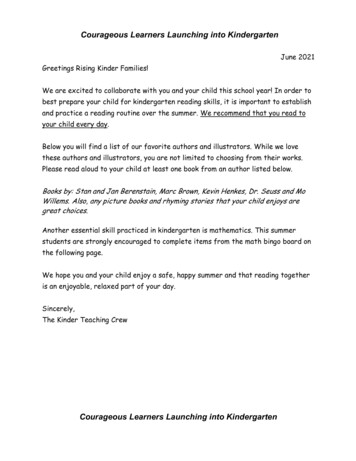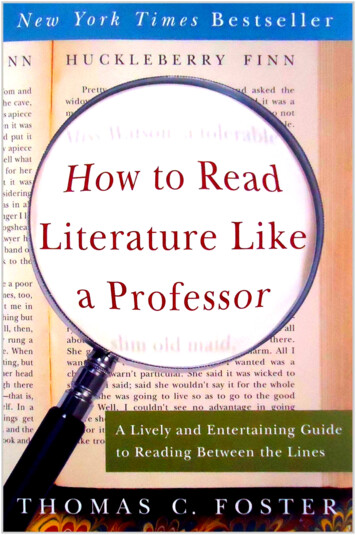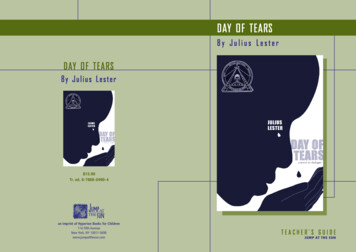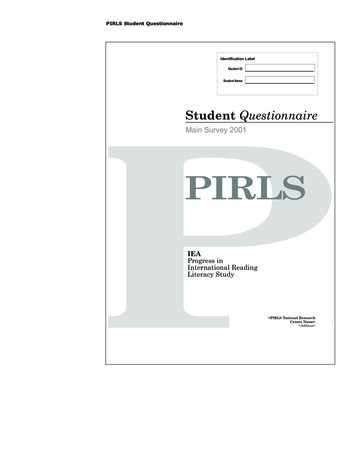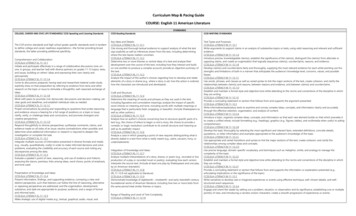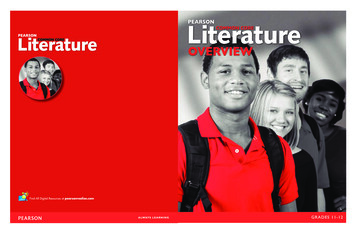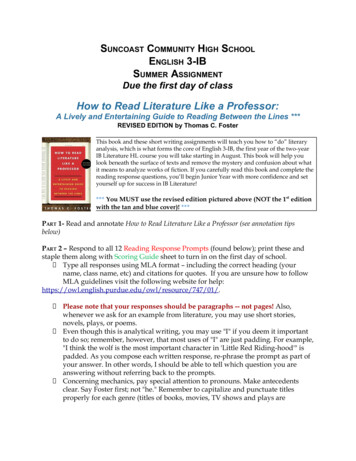
Transcription
SUNCOAST COMMUNITY HIGH SCHOOLENGLISH 3-IBSUMMER ASSIGNMENTDue the first day of classHow to Read Literature Like a Professor:A Lively and Entertaining Guide to Reading Between the Lines ***REVISED EDITION by Thomas C. FosterThis book and these short writing assignments will teach you how to “do” literaryanalysis, which is what forms the core of English 3-IB, the first year of the two-yearIB Literature HL course you will take starting in August. This book will help youlook beneath the surface of texts and remove the mystery and confusion about whatit means to analyze works of fiction. If you carefully read this book and complete thereading response questions, you’ll begin Junior Year with more confidence and setyourself up for success in IB Literature!*** You MUST use the revised edition pictured above (NOT the 1 st editionwith the tan and blue cover)! ***PART 1 - Read and annotate How to Read Literature Like a Professor (see annotation tipsbelow)PART 2 – Respond to all 12 Reading Response Prompts (found below); print these andstaple them along with Scoring Guide sheet to turn in on the first day of school.Type all responses using MLA format – including the correct heading (yourname, class name, etc) and citations for quotes. If you are unsure how to followMLA guidelines visit the following website for 47/01/ .Please note that your responses should be paragraphs -- not pages! Also,whenever we ask for an example from literature, you may use short stories,novels, plays, or poems.Even though this is analytical writing, you may use "I" if you deem it importantto do so; remember, however, that most uses of "I" are just padding. For example,"I think the wolf is the most important character in 'Little Red Riding-hood'" ispadded. As you compose each written response, re-phrase the prompt as part ofyour answer. In other words, I should be able to tell which question you areanswering without referring back to the prompts.Concerning mechanics, pay special attention to pronouns. Make antecedentsclear. Say Foster first; not "he." Remember to capitalize and punctuate titlesproperly for each genre (titles of books, movies, TV shows and plays are
underlined or italicized; TV episodes; poems and short stories are put inquotation marks).PART 3 – Be prepared to apply the knowledge and understanding gained from yourstudy to a piece of text (short story, poem, etc) in the first week as an assessment ofunderstanding.A few notes about IB Literature . . .The Big Picture?As you begin your IB DP courses in August, you may notice that some of theterminology will overlap: think -- learner profile traits such as communication,research, caring, knowledge, etc. ; approaches to teaching and learning (collaboration,inquiry, research, self-management, etc.) ; and international-mindedness. Theseoverlapping ideas are part of every course and the DP Core (TOK, CAS and the EE).They will help you make connections between your classes and the world outsideclassroom walls.What does this have to do with my summer assignment?It may seem overwhelming to think about the mindset that informs the IB big picture,especially when summers are meant to help you unplug from school life, but the IB bigpicture is much more than coursework. It’s a way to wrap your head around just aboutanything from your passion for baseball, or swimming, or cooking, to your greatestfears or biggest accomplishments. IB is about learning and knowing and figuring outhow to solve your own problems. It’s a way for you to connect what you learn to whatmatters most to you. In short, the Learner Profile, Approaches to Teaching andLearning, and “international mindedness” are as much a part of your summer off thisgrid as they are a part of this assignment.As you study How to Read Literature Like a Professor, this guide will remind you of a fewIB concepts that you’ll see in other classes, as well as concepts that are specific to IBEnglish Literature.What? IB English Literature is conceptual? I thought that was just mathclass?Yes, contrary to popular belief, IB Literature isn’t just about reading books and learninghow to write about them. It’s about getting to the heart of why we read in the firstplace. Of course, we all read for utility purposes. If you can’t read your menu at arestaurant then it’s difficult to place an order. But in literature class, we are not simplyreading to order off a menu; we read to understand each other’s stories. We read so thatwe can walk around in another person’s world and view it from their perspective. Weread to feel -- anything and everything: joy, pain, anxiety, peace, empathy. This journey
through multiple perspectives helps us understand others in the hopes of betterunderstanding the world and our place in it.We’ve just discussed WHY. But HOW do we read? The conceptual aspects of thiscourse will help us unpack the HOW. In your IB Literature course, you will considerthree distinct (and overlapping) areas of exploration as you unpack texts:1. Readers, Writers, and Texts2. Time and Space3. Intertextuality: Connecting TextsNOTE: You will be discussing this terminology over and over throughout the next twoyears. In the next few paragraphs we’ll explain a bit more about these areas ofexploration, but know that they are embedded in all parts of the course. Look for theboxes next to the questions in your response prompts so that you can be aware of whichspecific area of exploration is in play.Readers, Writers and Texts: In 10th grade, when you took APLanguage and Composition, you were taught how to read texts closelyand with a purpose. You looked carefully at the writers’ choices:imagery, diction, even sentence length helped you better understand thetext. You m attered in this equation too. Your own experiences helpedyou develop a response to the text -- a way in, so that you couldunderstand what you read in relation to your own context. This is the heart of“readers, writers and texts .” It’s about reading closely with a purpose. It’s aboutcoding and decoding language. It’s about figuring out how a passage or poem works ata cellular level.Time and Space: This area focuses on texts in context. It suggeststhat where and when a text is written matters. It’s about consideringhow texts operate in time and in their surroundings and how suchsurroundings affect meaning.Intertextuality: Connecting Texts : This area of explorationfocuses on how texts connect with each other and with the worldaround us. If you have ever watched a film or read a book andrecognized a reference to another text to help make sense of what’s infront of you, you’ve experienced intertextuality. Intertextuality canbe intentional or not. Perhaps the texts shared a certain theme -broken relationships, for example -- but they did so in different ways or throughdifferent mediums. Considering texts in relation to each other can help deepen ourknowledge and make connections. The comparisons can be illuminating, eventransformative.
READING RESPONSE PROMPTS1. Describe what Foster means by a “language of reading” (p. xxv).Describe how memory, symbol, and pattern are important for a“language of reading.” Describe “symbolic imagination” (p. xxviii)and how it is significant for a “language of reading.”2. Foster writes, “There’s no such thing as a wholly original work ofliterature” (p. 24) and “there’s only one story” (p. 27). Describe whatFoster means by these statements. To what extent do you agree ordisagree with these statements? Provide textual evidence fromchapters 4, 5, 6, 7, and 8 to support your claims.3. Foster writes, “We want strangeness in our stories, but we wantfamiliarity too” (p. 58). Explain this paradox. How does this idea helpyou to think more about the significance of allusions in literature?4. Explain how rain and snow are often paradoxical symbols (seepages 71-73). Explore some of the different atmospherics and moodthat are created by rain and snow, and explain how they often havecontradictory effects.5. In chapter 11, Foster describes “lateral thinking” (p. 93) and itsimpact on literary composition. What does this phrase mean? Howdoes this help you to (re)think the role of writer’s intentionality andwhat readers can discover in a work?6. Foster says, “I hate political writing” (p. 116) and then also says, “Ilove political writing” (p. 117). Explain this love-hate relationship.What are the differences between the political writing he hates andthe political writing he loves? Can you think of contemporaryexamples for each? He also says that, “nearly all writing is political onsome level” (p. 118). To what extent do you agree or disagree withthis statement? Explain.
7. After you finish Chapters 19-20 (pp. 171-192), read the short story,“Ripe Figs,” by Kate Chopin. The story is only 288 words total, andyet manages to say so much. You can find an online copy of the storyhere . What do you make of the significance of geography and seasonin this short story? How do they “matter?” Apply some of the ideasfrom chapters 19-20 to gain insights into this story.8. What is intertextuality? Foster introduces this idea early on (seepp. 29-30, 38) and clarifies it in the Interlude (p. 196-199). Identifyand explain some examples of “this dialogue between old texts andnew” (p. 29). What is an archetype? (see pp.198- 200) Explain howintertextuality and archetype support the statement: “There’s onlyone story.”9. Read the lyrics to “One Little Song” by Gillian Welch. The lyricsare available here . How do these lyrics help you to think moredeeply about intertextuality and Foster’s premise that “there’s onlyone story?” What other song lyrics or poems can you think of toillustrate some of the big ideas in the text? Brainstorm some titlesand explain the relationships and connections.10. Respond to this quotation by Clifton Fadiman: “When you reread aclassic you do not see more in the book than you did before; you seemore in you than there was before.” How does this quote inspireand/or clarify your thinking about some of Foster’s assertions,particularly the ideas he presents in chapter 24, “Don’t Read with YourEyes?”11. In Chapter 25, Foster encourages us to discover possibilities“beyond the literal” (p. 243) to interpret texts. Apply this idea inexplaining some of the literary terms used throughout the book.Create or find images and symbols to figuratively represent thesewords: allegory, archetype, intertextuality, irony, paradox. Explain thesymbolic representation you chose. (You can attach these to the end ofyour Reading Response Questions or paste them directly in.)12. Foster sums up irony as “deflection from expectation” (p. 256) andconcludes that irony trumps everything. What do these phrases mean?How do these ideas shed light on your understanding of irony? Canyou think of a movie or television show that you have “read” recentlywhere irony was present? What layer(s) did irony add to thefilm—comic, tragic, wry, perplexing, etc.? Explain.
How to score well:(See attached scoresheet for specific breakdowns, but this will serve as a guide as to how toachieve each percentage band)“A” 90-100% - This grade will be awarded to students who follow the directions asoutlined above with great care. Their writing will reflect organization, structure, anddepth of thought and analysis. Students receiving this grade will also turn in work thatis neat and organized in its presentation and that is free of excessive and distractingerrors in its technical merit.“B” 80-89% - This grade will be awarded to students who follow the directions as givenabove, but may include students who have difficulty producing writing that reflects theorganization, structure, and depth of thought found in the “A” grading range.Responses at this level may have slight, but not distracting problems in the area oftechnical merit.“C” 70-79% - This grade will be awarded to students who have minor issues infollowing the directions as outlined above, but who still manage to give attention to andrespond to all required reflection prompts. These students may show more significantissues in organization, structure, or analytical depth than those receiving the “B” grade,or may have frequent and repeated problems with the technical merit of theirassignment.“D” 60-69% - This grade will be given to students who fail to complete all requiredresponses or who do not produce focused or coherent responses to the requiredprompts. Students receiving this grade may also have major and distracting errors inorganization, structure, depth of thought, command of language, or technical merit.“F” 59% or below – This grade will be given to students who submit responses that aremostly incomplete, completely unfocused or incoherent in relation to the requiredprompts, or that display little to no skill in organization, depth of analysis, command oflanguage, or technical merit.Annotating Your Novel: Some Tips· Highlight or underline notable words, phrases, and/or sentences and write questions,comments, connections, and reactions in the margins. Questions -- ask about something you don’t understand. Comments -- note instances of interesting word choice, imagery, charactermotivations, and literary devices, etc. that might suggest an author’s purposeor theme. Connections -- make text-text connections (ways the book relates to anotherbook, a movie, television show, an article, etc.), text-self connections (waysthe book relates to you), text-world connections (ways the book relates tothings that exist in our society)
Reactions -- this can be something you think is funny or interesting,something you agree with or disagree with. Write any insights or ideas about the novel on the title page or inside covers of thebook.
Name:English Teacher/Block:Suncoast Community High SchoolEnglish 3-IBSummer Assignment Scoring Guide(staple this sheet to the back of your assignmentwhen you submit it on the first day of school)Assignment Components and PointsFormat (25 points) 12 point New Times Roman 1 in margin Double spaced Name information in upper left corner (first page of documents only)NameEnglish 3-IBSuncoast High SchoolDate/5/5/5/5 Order of Presentation/5TOTAL (A)/25Writing Prompt Responses (50 points)/50Application Assessment - first week of school (50 points)/50TOTAL (B)TOTAL (A B)Scoring BreakdownPoints EarnedGrade24 and lowerF25 - 49D50 - 74C75 – 99B100 – 125A/100/125
It's about getting to the heart of why we read in the first place. Of course, we all read for utility purposes. If you can't read your menu at a restaurant then it's difficult to place an order. But in literature class, we are not simply reading to order off a menu; we read to understand each other's stories. We read so that
